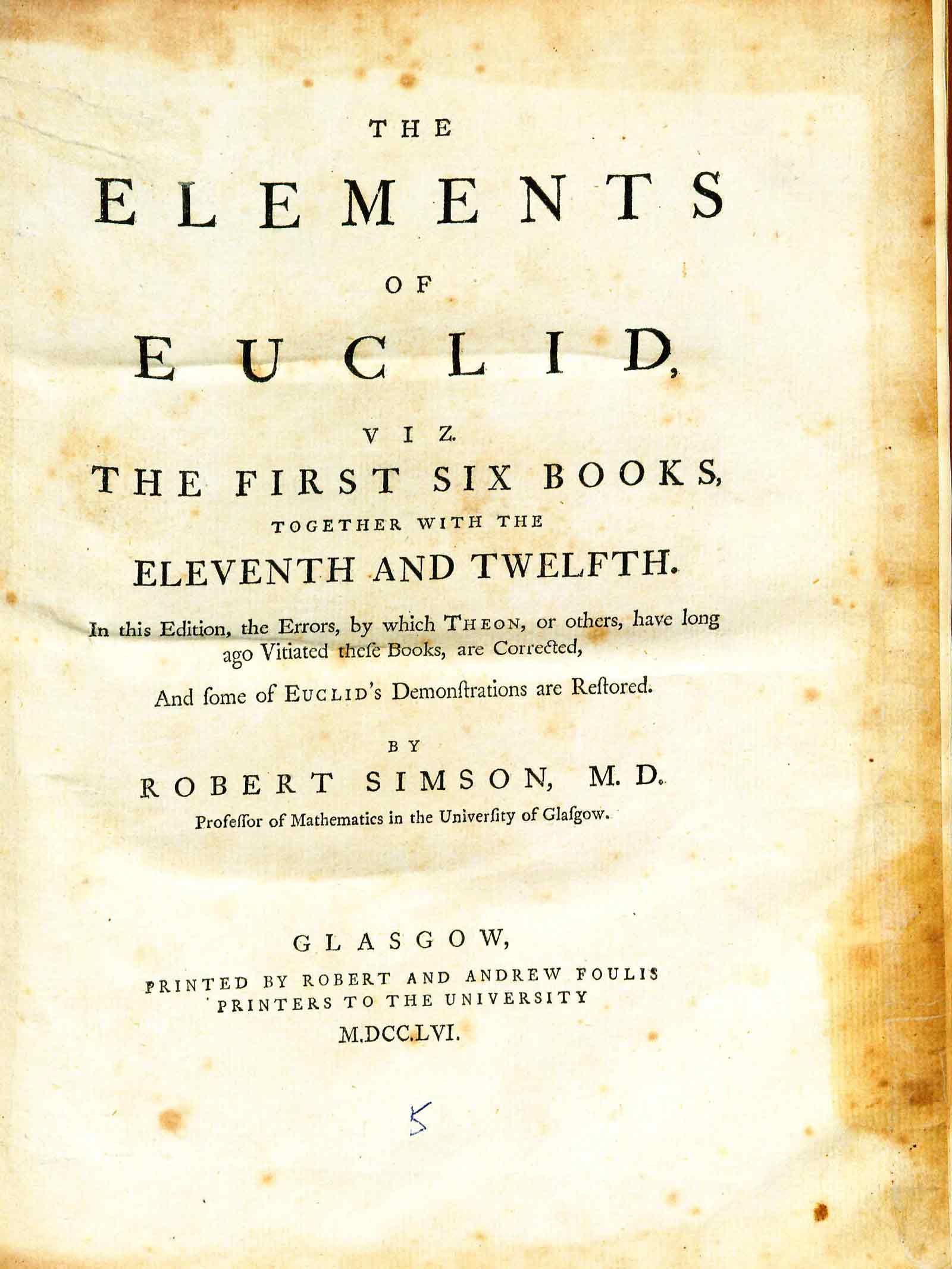The Elements of Euclid
The Elements of Euclid: viz. the First Six Books, Together with the Eleventh and Twelfth. In this edition, the Errors, by which Theon, or Others, have Long Ago Vitiated These Books, are Corrected, and Some of Euclid's Demonstrations Restored
by Euclid
| Elements of Euclid | |
|
Title page from Elements of Euclid, George Wythe Collection, Wolf Law Library, College of William & Mary. | |
| Author | Euclid |
| Editor | Robert Simson, M.D. |
| Published | Glasgow: Printed by Robert and Andrew Foulis, Printers to the University |
| Date | 1756 |
| Language | English |
| Pages | 440 |
Euclid was a Greek mathematician who is often referred to as the “Father of Geometry”. His specific date of birth and death are unknown, but many historians estimate that he lived sometime around 300 BCE.[1] Despite the uncertainty surrounding his biographical details, his presence in history deeply resonates by means of his works in the field of mathematics, especially in geometry.
Elements is the title of Euclid’s most well-known and influential work. In Elements, Euclid presents definitions, postulates, and mathematical proofs on a wide range of mathematical concepts.[2] Many of these concepts were based on prior mathematical finding and therefore were not entirely new revelations to the field of mathematics, but Euclid’s presentation of these concepts in a single, logically coherent framework created a system that served as a pillar of mathematics for two thousand years.[3] Elements enjoyed enormous critical acclaim and was considered to be highly relevant to the field of mathematics until the early twentieth century.[4] Euclid's Elements has been referred to as the most successful and influential textbook ever written.[5] Elements is one of the earliest mathematical works to be printed after the invention of the printing press and was estimated to be second only to the Bible in the number of editions published, with the number reaching well over one thousand.[6]
Evidence for Inclusion in Wythe's Library
Description of the Wolf Law Library's copy
Bound in a modern full leather binding of brown calf, raised bands, and gilt lettering on a red spine label. Purchased from Peter Rhodes Books.
Find this book in William & Mary's online catalog.
References
- ↑ Encyclopædia Britannica Online, s. v. "Euclid," accessed October 03, 2013, http://www.britannica.com/EBchecked/topic/194880/Euclid.
- ↑ Ibid.
- ↑ Dirk Jan Struik, "Ancient Greek Mathematics," in A Concise History of Mathematics, 4th rev. ed. (New York (N.Y.): Dover, 1987), 51.
- ↑ Charles Lutwidge, and Amit HagarDodgson, "Introduction," in Euclid and his Modern Rivals (Mineola, N.Y: Dover Publications, 2004), xxviii.
- ↑ Carl B. Boyer, and Uta C. Merzbach, "Euclid of Alexandria," in A History of Mathematics, 2nd ed. (New York: Wiley, 1991), 119.
- ↑ Lucas N. H. Bunt, Phillip S. Jones, and Jack D. Bedient, "Greek Influence," in The Historical Roots of Elementary Mathematics (New York: Dover Publications, 1988), 142.
